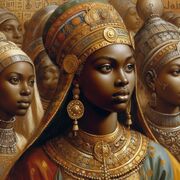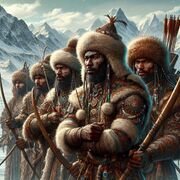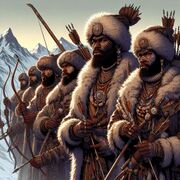Kandara
| This article is a stub. You can help IxWiki by expanding it. |
Sovereign and Independent People's Republic of Kandara Kandhera | |
|---|---|
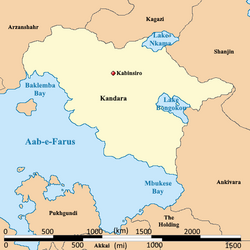 Location of Kandara | |
| Capital | Kabinsiro |
| Largest city | Port of Bomonba |
| Official languages | Kandaro, Burgoignesc language |
| Ethnic groups | Primarily Kandi |
| Religion | Shia Islam, or Mercantile Reform Protestantism in a 60/40 split |
| Demonym(s) | Kandari (noun) Kandaran (adjective) |
| Government | Kraterocracy |
• Admiral-General | Stephan Mojalefa |
| Establishment | |
| 1795 | |
| Area | |
• | 1,515,583.34 km2 (585,170.00 sq mi) |
| Population | |
• Estimate | 18,476,480 |
• Density | 12.191/km2 (31.6/sq mi) |
| GDP (nominal) | estimate |
• Total | $32,389,269,440 |
• Per capita | $1,753 |
| Currency | Common Middle Sea Florin (CMS ƒ) |
Kandara, officially the Sovereign and Independent People's Republic of Kandara, is categorized as a least developed country nation in central Audonia. It is bound by the Aab-e-Farus in the east, Arzanshahr in the northwest, Kagazi in the north, and Shanjin and Ankivara in the east. It is known as the world's only kraterocracy run by a violent military regime led by Admiral-General Stephan Mojalefa.
It is a member of the League of Nations, the International Red Cross and Red Crescent Movement, and many other international organizations, but is not an active participant, rather an aide recipient.
It is a command economy focused on raw resource extraction and export, under the watchful eye of Burgundie whose companies have a massive stake in the country's economic activity. Despite its status as a failed state, it is an active member in the Middle seas region's economic activity due primarily to the sheer size of its mineral wealth.
Many scholars have criticized its economic governance and politics, arguing that it is merely a client of the Burgoignesc thalattocracy's economic and cultural might.
The people of Kandara are predominantly culturally Kandi, speak Kandaro, and most practice Shia Islam, or Mercantile Reform Protestantism in a 60/40 split.
Government and politics
Administrative divisions and municipalities
Society
-
A big ole' Kandaran baby
Art
Storytelling is a cornerstone of Kandaran life. {wp|Griot}}s, communal storytellers in the same tradition as medieval Occidental bards, preserve the history and myths of their tribes with tales of heroism, folly, marriages, lifes, and deaths of key figures. These stories are not just for entertainment; they are the codification of tradition, passing down knowledge of survival skills, tribal history, and moral codes of the tribes in which they are told. Art too, serves as a powerful medium for cultural expression of the Kandari people. Among the unique art styles of Kandara, sand paintings, depicting scenes of daily life, spiritual beliefs, and historical events are the most internationally recognized and enduring symbol of Kandaran art. Sculptures carved from ebony or weathered stone depicting revered ancestors and mythical creatures that populated the pre-Islamic and pre-Christian Kandaran pantheon, these figures have made a return to the Kandaran art scene in the latter half of the 20th century, especially during and after Operation Kipling when some Burgoignesc and Urcean soldiers brought some of the ancient statues back and they made a splash in those countries art scenes in the late 60s.
Religion in Kandara is a complex reflection of the nation's violent and colonial history. The majority adhere to Shia Islam, a vestige of the area's domination by the Oduniyad Caliphate. Mosques, serve as centers not just for prayer, but also for education and social gatherings, especially in the interior. However, a significant minority practices Mercantile Reform Protestantism, a faith introduced by the Burgoignesc colonizers. Simple white clapboard churches, testaments to a bygone era of colonial dominance, stand as stark reminders of a troubled past, and stand in direct contrast to the massive and opulent mosques. While religious tolerance is generally practiced, tensions occasionally flare, particularly in competition for influence within the government or control of resource-rich areas.
La Sape
Further: La Sape
Kings, just kings for days.
Music
-
Santasi people playing the xylophone in 1914
History
Prehistory
Myanga Ayil Khanate
Cote d'Or colony
The Burgoignesc colonization of Kandara, spanning from 1598-1795, began with the arrival of Kiravian explorers in the late 15th century, drawn by rumors of gold. The subsequent entry of the Duchy of Marialanus' South Sea Expedition Company (SSETC) in 1598 marked the official start of colonization. Initially, the SSETC adopted a more open approach, re-empowering local magistrates with ties to the former Oduniyyad Caliphate to gain access and trade advantages. This period (1598-1635) saw limited self-sufficiency in the colony, with heavy reliance on the Marialanii metropole. As the generation of Oduniyyad-appointed magistrates aged out, the SSETC tightened their grip (1635-1693). Power shifted towards direct control of politics, land management, and resource extraction. The patroonship system emerged, granting powerful individuals semi-autonomous control over vast latifundia plantations in exchange for loyalty and resource extraction. Chattel slavery became central to the colonial economy, primarily targeting populations outside Cote d'Or colony's major polities. A massive influx of Levantine Protestants, promised land grants, led to rapid coastal expansion and further displacement of native populations. Local militias, primarily composed of native levies, served as the initial line of defense against resistance on the expanding frontiers. By the late 17th century (1693-1785), the SSETC consolidated power further, establishing centralized administrations and presidencies for efficient control, abolishing the natively run protectorates. Demographic shifts due to immigration and slavery resulted in some colonies achieving majority Bergedii and Deric populations, creating internal tensions. Colonial militias were gradually replaced by professional regiments directly controlled by the SSETC, incorporating subjugated native peoples. Utilizing these well-equipped forces, the SSETC embarked on aggressive territorial expansion, drastically enlarging the colonial borders. However, the seeds of decline were sown during this period (1785-1795). The SSETC became increasingly corrupt and focused on prestige, neglecting efficient administration and development. The vast size and mismanagement of the Cote d'Or colony proved unsustainable, leading to discontent and separatist movements. High taxes and tariffs on both settlers and native populations fueled resentment, while insensitive leadership and disregard for native customs sparked widespread mutinies within native regiments. The Great Rebellion of Slavery Bay ignited a domino effect, leading to uprisings across major colonies, a mass exodus of Occidental settlers, and plunging the colonies into chaos. Poor leadership and internal conflicts within both the colonies and the Marialanii metropole ultimately resulted in the loss of Cote d'Or colony. The legacy of Burgoignesc colonization remains deeply embedded in contemporary Kandara. While resistance left its mark, lingering influences of Burgoignesc language, religion (Mercantile Reform Protestantism), and architecture are still discernible. The extractive colonial economy left Kandara with depleted resources and underdeveloped infrastructure, contributing to its current status as a least developed country. Perhaps most significantly, the fractured tribal landscape exploited by the Bergendii continues to influence Kandara's political complexities and internal divisions, shaping the nation's ongoing, violent pursuit of unity and development.
Colonial administration
In Cote d'Or, power flowed downwards from the Duke of Marialanus, through the appointed Governor-General and the ever-watchful South Sea Expedition Company (SSETC). At the heart of the system lay the patroons, powerful individuals granted vast Latifundia in exchange for loyalty, resource extraction, and settlement development. These semi-autonomous lords held sway over their domains, levying taxes, administering justice, and commanding local militias. Tenant farmers and non-patroon settlers, primarily Deric and Bergendii protestant immigrants, possessed a limited voice through a Colonial Council. This body, however, held little real power, serving more as an advisory board than a true decision-making body. The Kandari people, meanwhile, were excluded entirely from formal power structures, governed only by their own traditions and facing limited opportunities within the colonial hierarchy. This system, initially designed for efficiency, shifted towards authoritarianism as challenges arose. Mounting resistance, internal corruption, and economic pressures led to stricter controls, increased military presence, and marginalization of both the Kandari and the Colonial Council. Local militias were replaced by professional regiments controlled by the Governor-General, tightening the grip of the central administration. Cote d'Or's administration thus reflected a stark hierarchy, with wealth and influence concentrated in the hands of the colonial elite. While non-patroon settlers held a semblance of participation, the Kandari people remained disenfranchised, foreshadowing the tensions and conflicts that would mark the colony's future.
The colonial administrators were master negotiators and strategists and were always looking for ways to expand their colonial boundaries. They used the TerreRaubeuers to masterful effect and generally kept the colonists engaged in Colonial militarism and proselytization. They also knew and worked to keept he tribes divded and at war with eachother. They were also adept at using the Doctrine of Lapse.
Colonial economy
The bustling economy of Cote d'Or showed the tenacity, resourcefulness, and ambition of its Bergendii and Deric colonists. They set about building roads and ports as soon as they arrived and connecting their emporia to the existing Silk Road with haste. The initial and staple commodity that led to the colonization of the area was salt. The patroon system allowed them to establish latifundia immediately which soon boasted towering date palms, yielding sweet fruits and sap, which was exported as a delicacy and sweetener. As the colony expanded into the semiarid interior, massive cattle and cotton latifundia were established, which was fed into the existing textile industry in Kandara. Bergendii and Kandari weavers became renowned for their skill, crafted fine cloth coveted across Levantia and Sarpedon. As they spread further into the foothills, the humid highlands was harnessed to industrialized the cultivation of cardamom, ginger, turmeric, and, in select highland pockets, tea plantations. Nestled amidst the secrecy of the highlands, poppy fields bloomed, yielding raw opium, a highly profitable commodity that was used in Kandara as well as other colonies when the population was unruly.
Modern-day period
First Great War
Geography
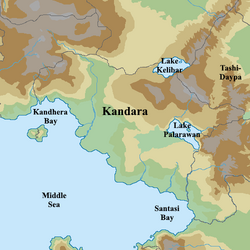
-
Kandaran coast
-
Kandaran coastal plain
-
Farming in the interior
-
Kandaran highlands
-
Fishing village
-
"The Scrub" of the coastal plains
Kinkasendjo mountains
Climate
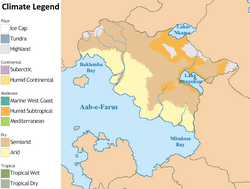
Because of its location, at the eastern end of the tradewinds, Kandara is exceptionally arid. Any moisture from the interior plains of the Dolong region of Audonia catching in the Kinkasendjo mountains before it reaches the Kandara coastal plains.
Military
Army of Kandara
Traditional state military with traditional weapons and equipment contracts with respected overseas countries, namely Burgundie, Urcea, and Yonderre. Mixed of mechanized and unmechanized forces with some air support. Fully logistically supplied by the state.
Kando Lalrissian's Army of God
Religiously-based militia, numbering around 5,000 soldiers, supported by proxy from large external states using intermediary buyers.
People's Liberation Army of Gabo
Regional socialist independence army for the region of Gabo. There are around 7,000 soldiers almost entirely mechanized in technicals.
General Fully Clothed's Janjaweed
Cult of personality around General Fully Clothed (ne Othiamba Adiwuor). numbering around 450 soldiers, based on the season.
Loko Haram
Anti-occidental, Burgophobia Islamist militia, numbering around 2,500. Mix of partisan irregular infantry and technical-mounted attack squads
Economy
Infrastructure
Rail
Kandara uses Standard gauge, 1,435 mm (4 ft 8+1⁄2 in) as most of its rail infrastructure has been under the auspices of Burgundie and its sphere of influence in the Middle seas region, who all use that rail gauge.
Roads
Louage
A louage is a minibus shared taxi in many parts of Daria that were colonized by Burgundie. In Burgoignesc, the name means "rental." Departing only when filled with passengers not at specific times, they can be hired at stations. Louage ply set routes, and fares are set by the government. In contrast to other share taxis in Audonia, louage are sparsely decorated. Louages use a color-coding system to show customers what type of transport they provide and the destination of the vehicle. Louages with red lettering travel from one state to another, blue travel from city to city within a state, and yellow serves rural locales. Fares are purchased from ticket agents who walk throughout the louage stations or stands. Typical vehicles include: the MILCAR Jornalero, the TerreRaubeuer Valliant 130, and the CTC M237-07.
See also
















